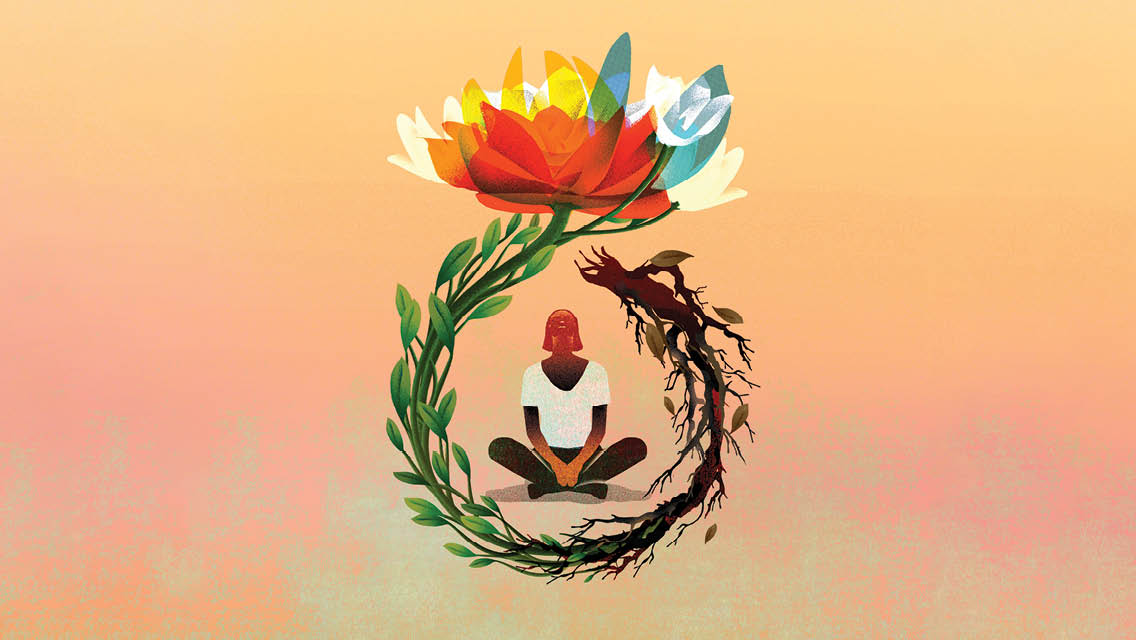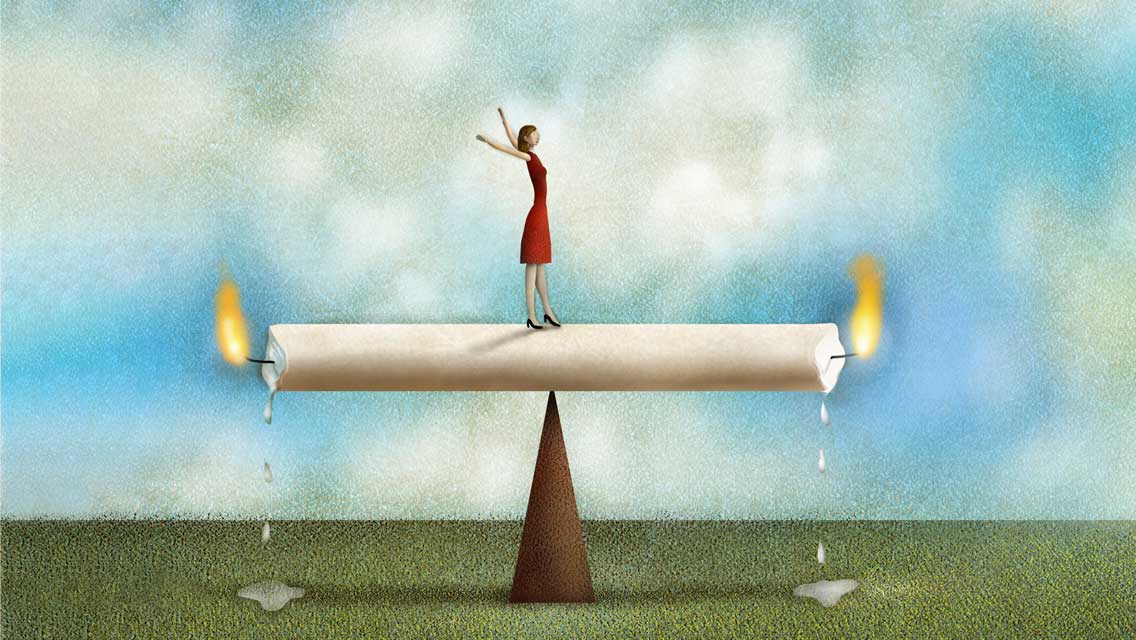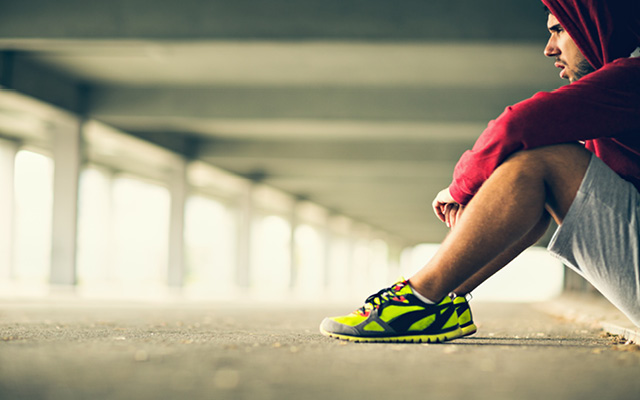I want to bring you into one of the workshops on burnout that I lead with my twin sister, Amelia.
Imagine walking into a converted New England barn: shiplap and rag rugs, sunlight filtering in from high windows, and the smell of salt air on the breeze blowing in from the beach. Women of all kinds are mingling at the beverage station or finding a place to sit. Pick a comfy spot and make yourself at home.
Amelia and I joke with each other, to show you it’s OK to play in this space — and then we tell you the story of how we came to teach this workshop.
While working two part-time jobs and stepparenting three teenagers, Amelia was enrolled in a full-time doctoral program in a highly competitive, male-dominated field (she remains the only woman ever to have completed that degree program). It took her five years, and it put her in the hospital twice.
The doctors couldn’t find anything wrong . . . except Amelia’s white-blood-cell count was through the roof and the pain in her abdomen felt lethal. Still, the doctors said there was nothing wrong. “It’s just stress,” they told her. “Go home and relax.”
Relax? With two part-time jobs, three teenagers, and a full-time academic program in which the very fact of her body’s shape made her an interloper, unwelcome, and disregarded? Relax?
I’m a health educator; sex is my specialty. But because the best predictor of a woman’s sexual well-being is — surprise! — her overall well-being, I spend a lot of time talking about the science of stress and burnout, relationships and feelings. So, I started sharing peer-reviewed science with my highly skeptical sister.
This research shows that stress is a response that affects just about every organ system in the body. One book described how many of the chronic health issues that had plagued Amelia — repeated infections, asthma, back pain, and now this abdominal pain — were textbook examples of how the body deals with unprocessed emotion.
Amelia recalls thinking it was some “New-Agey nonsense.” But she was in so much pain all the time, and it was getting worse. So she called me.
She said, “I’m reading this book and it says . . .” She couldn’t continue without sobbing. “It says unprocessed emotions are hidden in the body. Is that true? Is my pain . . . my rage?”
And I said, “You didn’t know that?”
“How could I have known that?!”
So I gave her some more books.
Over the next five years, Amelia became healthier than she had ever been, and felt like the changes had saved her life. She learned that, yes, emotions can be stored in the body, causing physical discomfort and pain — and that you can release emotions through your body, through relationships, even through imagination.
It felt miraculous, yet it was simple.
It turns out, the strategies for addressing burnout — the physical, emotional, and spiritual depletion that results from unrelenting stress over time — are accessible to just about everyone. They’re also enjoyable, and most of them are free.
Free. Fun. Easy. And you can start feeling better today. So much good news!
And then there’s some bad news.
And then there is so much more good news!
Let’s start with the good news: We know that burnout happens when we get stuck in the middle of a biological stress-response cycle. We also know that to heal from burnout, we need to complete that cycle. So, to understand how to make this work in your life, there are four things to consider:
- The causes of your stress.
- The sources for healing the stress in your body.
- The barriers that stand between you and whatever heals your stress.
- The community approach to overcoming those barriers.
Let’s go through each of these.
The Causes Of Your Stress
This is the easy one. I bet you could write a list off the top of your head right now: work, money, kids, family, partner (or lack thereof), past traumas, the threat to Black lives in America, body-image stuff and other forms of self-criticism, all the ways you don’t match whatever “ideal” you’ve been assured you’re “supposed” to match, lack of time, lack of sleep. I could go on. So could you.
The causes of your stress include anything in your external environment or your internal state that your brain interprets as a potential threat.
If we were in a workshop together right now, you’d write a list of all the things that cause your stress, everyone in the group would read some of theirs aloud, and you’d find yourself adding things from their list to your own. The list would be long, and just the sight of it might overwhelm you. Never fear — there is so much good news coming your way. Ready?
You do not have to deal with all your stressors before you begin to heal your stress!
What Resolves Your Stress
Humans evolved in an environment where they faced physical threats to life and limb, so our stress response is optimized to save our lives by preparing us to fight or flee.
Imagine: If you’re chased by a lion, you get a flood of cortisol and adrenaline and glucocorticoids (oh my!) that shut down digestion, reproduction, and long-term reasoning so all your energy is available for survival. Then you run until you reach a safe place, and all those neurotransmitters have been used up, and you feel drained but also elated and powerful. The sun shines brighter. You love your friends and family. You feel glad to be alive.
This is the complete stress-response cycle that happens in your body. It’s one of many natural human cycles: stress and safety; work and rest; sleeping and waking; inhalation and exhalation; eating and digesting. Our stress response is more or less the same whether our stress comes from fleeing from a lion or doing our taxes.
But has doing your taxes ever made you feel thrilled to be alive?
You’re eliminating a source of stress, so it should, right?
Nope.
Eliminating a stressor without completing the stress-response cycle will leave our bodies in the middle of the stress cycle, with digestion all screwed up, reproduction a mess, our muscles tensed unnecessarily. All of these incomplete stress cycles are spinning away in our bodies, waiting for us to grant them an opportunity to complete.
Meanwhile, they degrade all the bodily functions altered by the stress cycle. We suffer digestive distress, we struggle with fertility, we live with chronic pain or recurrent infections — all because our bodies are trying to keep us safe until we do something that allows our bodies to complete the cycle.
The sad irony is, these days, our stress is more likely to damage our health than the threat that activated it.
The stress response is not inherently any more dangerous than inhalation or eating — it’s simply something our bodies do to stay alive. The danger is getting stuck in the middle of that cycle, never coming out the other side.
To prevent the damage caused by stress that’s stuck, we have to complete the stress cycle. How? Not by dealing with your stressors.
Doing your taxes will help your stress as much as doing the dishes will help your digestion. It has to be done, but it’s not what your body needs.
Because of the nature of our stressors, we have to deal with the stress in our bodies separately from dealing with the causes of our stress. So, what completes the stress cycle?
When you’re being chased by a lion, what do you do? You run.
When you’re stressed out by work, family, money, or The Future, what do you do? You run.
Remember, the physiology is basically the same, and therefore the strategy to complete the cycle is the same.
It doesn’t have to be running, of course: Any movement that challenges your muscles helps. Do jumping jacks. Dance it out to Beyoncé. You can even just lie in bed and tense every muscle in your body for a long, slow count of 10 before letting them all relax. Any movement will help tell your body it’s safe.
Physical activity isn’t equally effective for everyone. If we were out in the barn in a circle of women, I’d ask you if exercise worked for you. Maybe half of you would raise your hands and have stories of feeling great after swimming, walking, or playing tennis. Then I’d ask who thinks these stories sound made-up, and many others would raise their hands, including Amelia.
More good news: Exercise is not the only way to complete the stress-response cycle. There are others, including these:
A big old cry. Lots of us know the relief that comes from just locking ourselves in the bathroom, crying, and then walking out feeling relieved and ready to take on the world again.
Creative self-expression. When you make something just for the pleasure of making it, not necessarily to sell or to serve a particular purpose, you allow your body to process feelings and experiences somewhere safe and satisfying.
Imagination. If you’ve ever felt that satisfied, thrilled, glad-to-be-alive feeling walking out of a movie theater, or after reading a book, then you know that allowing your imagination to go through an intense journey can complete a stress cycle.
Belly laughter. Polite, posed, social laughter doesn’t count. It works best when it’s uncontrollable, open-mouthed, ridiculous laughter that leaves you panting and exhausted. (See “The Surprising Benefits of Laughter — and Tips to Find More of It” to learn more about the health benefits of laughing.)
Connection. It can be with other people, animals, nature, the divine, or whatever makes you feel like you’re part of a larger world that will hold you in safety. Even a quick, friendly exchange with your barista will give your body a little reminder that it is safe.
A good night’s sleep. While you sleep, your brain solves problems from the day and finishes unfinished business, especially during REM.
Though that last item seems like it couldn’t be easier (we’re talking about going to bed, right?), this one can be especially challenging. We’ve lost count of the number of women who have told us they feel guilty for sleeping. Or that they’ve been praised so many times for pulling all-nighters or sacrificing sleep to take care of a sick partner or child that it has taught them that the “right” choice for a woman is to deprive herself of sleep.
You might be thinking something like, I know, I know. Sleep. Moving my body. Love and connection. Right, I know what I’m supposed to do. I’m such a failure, why can’t I even . . .
I’m going to stop you right there because that’s my friend you’re talking about and I’m not going to let you speak to her that way.
It’s not that you don’t know what’s good for you, or that you aren’t trying to do your best. We’re all trying our best all the time. But we still burn out.
Why do we feel guilty for sleeping? Why can we find the time to decorate cupcakes for a child’s birthday party but we can’t find the time to journal or dance or go for a walk around the neighborhood?
What is getting between us and our well-being?
The Barrier Between You and Healing Your Stress
So, here’s the bad news. Let me tell you about Human Giver Syndrome.
Human Giver Syndrome is the false belief that you have a moral obligation to be (1) pretty, (2) happy, (3) calm, (4) generous, and (5) attentive to the needs of others. Givers are expected to be willing — even eager — to sacrifice their time, attention, effort, emotions, bodies, hopes and dreams, and sometimes even their life on the altar of someone else’s comfort and convenience.
Because this is a moral obligation, if you fall short then you deserve to be punished. And if there’s no one around to punish you, you’ll just go ahead and beat yourself up.
“In reality, you do not owe it to anyone to be pretty, happy, calm, generous, or attentive to their needs. You get to choose when and how to give your time, energy, and love to others.”
Human Giver Syndrome is why we feel guilty for sleeping or taking time for ourselves. It’s why, if we try to “put on our own oxygen mask first,” we might feel bad. And we might even receive judgment from others, like, “Oh, you got enough sleep last night? That’s so nice for you. I was up until 4 finishing the project — but good for you. Self-care is so important.”
In reality, you do not owe it to anyone to be pretty, happy, calm, generous, or attentive to their needs. You get to choose when and how to give your time, energy, and love to others. And if you fall short of meeting your own or someone else’s expectations, you deserve compassion, not punishment.
Community Completes the Giving Cycle
OK, here is some more good news: Giving isn’t inherently dangerous, just as stress isn’t inherently dangerous.
The danger is getting stuck in a dynamic in which you keep on giving, and the people you give to feel entitled to take whatever you offer with no responsibility for reciprocating — and without noticing the toll your giving takes on you.
So here is just one powerful strategy for completing what we might call the “giving cycle”: Remember who the real enemy is.
Have you seen or read The Hunger Games? It’s about a near-future dystopia where a girl named Katniss has to fight in a “game” created by the government, in which children go into a dome and have to kill each other until only one is left.
Before the game, Katniss’s wise mentor warns her, “Remember who the real enemy is.”
In the game, Katniss is panicked, hunted, in full fight-or-flight mode. Another player in the game appears, and she points her bow and arrow at him. Then she remembers her mentor’s wisdom — and she points her bow and arrow up at the dome in which they are both trapped. Because the real enemy is not the other people in the game; it’s the bogus, appalling game itself.
This is the real solution buried in our story about Amelia the skeptic and the pile of peer-reviewed research that helped her recover: It wasn’t the science that saved Amelia’s life. It was her husband and her colleagues and me turning to her with kindness and saying, “You don’t have to set yourself on fire to keep other people warm. We will gather everything we need to stay warm together.”
What would this look like? Imagine coming home from a difficult day, and instead of people asking, “Hey, what’s for dinner?” they notice that you’re exhausted. They say, “Go take a nap and a shower. We will make dinner and we will sit around and talk about our feelings.” Protecting rest and other self-care requires a home where everyone wants to protect your well-being as much as you want to protect theirs.
Now look at the women and girls and femmes around you in the barn. For them, wish for lives in which they can give love and receive it. Where they can say, “I need some extra sleep tonight,” and everyone in their home does what it takes to protect the time and space required to allow that sleep.
“Self-care is not the cure for burnout. The cure for burnout is all of us taking care of each other.”
Turn to someone and tell her, “Let’s not play the game that would have us tear each other down. Let’s play by our own rules. Let’s play a game where we both win.”
The secret is that, for all the science about stress cycles and exercise and sleep, self-care is not the cure for burnout. The cure for burnout is all of us taking care of each other.
This article originally appeared as “Complete the Stress Cycle” in the September 2021 issue of Experience Life.





This Post Has 0 Comments